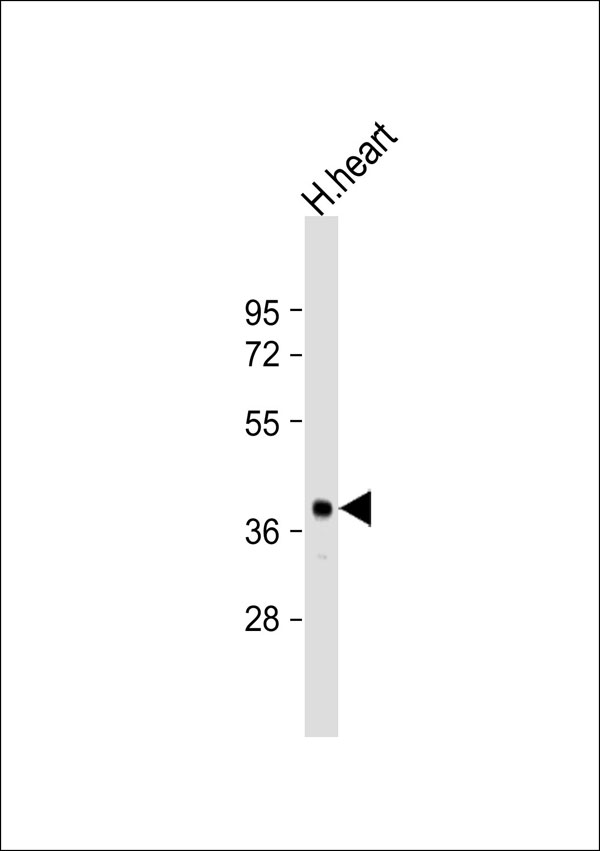PPM1K Antibody
Purified Rabbit Polyclonal Antibody (Pab)
- 产品详情
- 实验流程
- 背景知识
Application
| WB |
|---|---|
| Primary Accession | Q8N3J5 |
| Reactivity | Human |
| Host | Rabbit |
| Clonality | Polyclonal |
| Calculated MW | 40997 Da |
| Gene ID | 152926 |
|---|---|
| Other Names | Protein phosphatase 1K, mitochondrial, 3.1.3.16, PP2C domain-containing protein phosphatase 1K, PP2C-like mitochondrial protein, PP2C-type mitochondrial phosphoprotein phosphatase, PTMP, Protein phosphatase 2C isoform kappa, PP2C-kappa, PPM1K, PP2CM |
| Dilution | WB~~ 1:1000 |
| Format | Rabbit IgG in phosphate buffered saline , pH 7.4, 150mM NaCl, 0.09% (W/V) sodium azide and 50% glycerol |
| Storage | Store at -20 °C.Stable for 12 months from date of receipt |
| Name | PPM1K {ECO:0000303|PubMed:23086801, ECO:0000312|HGNC:HGNC:25415} |
|---|---|
| Function | Serine/threonine-protein phosphatase component of macronutrients metabolism. Forms a functional kinase and phosphatase pair with BCKDK, serving as a metabolic regulatory node that coordinates branched-chain amino acids (BCAAs) with glucose and lipid metabolism via two distinct phosphoprotein targets: mitochondrial BCKDHA subunit of the branched-chain alpha-ketoacid dehydrogenase (BCKDH) complex and cytosolic ACLY, a lipogenic enzyme of Krebs cycle (PubMed:17336929, PubMed:17374715, PubMed:19411760, PubMed:22291014, PubMed:22589535, PubMed:23086801, PubMed:29779826). At high levels of branched-chain ketoacids, dephosphorylates and activates mitochondrial BCKDH complex, a multisubunit complex consisting of three multimeric components each involved in different steps of BCAA catabolism: E1 composed of BCKDHA and BCKDHB, E2 core composed of DBT monomers, and E3 composed of DLD monomers. Tightly associates with the E2 component of BCKDH complex and dephosphorylates BCKDHA on Ser-337 (PubMed:17336929, PubMed:17374715, PubMed:19411760, PubMed:22291014, PubMed:22589535, PubMed:23086801, PubMed:29779826). Regulates the reversible phosphorylation of ACLY in response to changes in cellular carbohydrate abundance such as occurs during fasting to feeding metabolic transition. At fasting state, appears to dephosphorylate ACLY on Ser- 455 and inactivate it. Refeeding stimulates MLXIPL/ChREBP transcription factor, leading to increased BCKDK to PPM1K expression ratio, phosphorylation and activation of ACLY that ultimately results in the generation of malonyl-CoA and oxaloacetate immediate substrates of de novo lipogenesis and gluconeogenesis, respectively (PubMed:29779826). Recognizes phosphosites having SxS or RxxS motifs and strictly depends on Mn(2+) ions for the phosphatase activity (PubMed:29779826). Regulates Ca(2+)-induced opening of mitochondrial transition pore and apoptotic cell death (PubMed:17374715). |
| Cellular Location | Mitochondrion matrix. Note=Detected in the cytosolic compartment of liver cells. {ECO:0000250|UniProtKB:A6K136} |
For Research Use Only. Not For Use In Diagnostic Procedures.
Provided below are standard protocols that you may find useful for product applications.
BACKGROUND
Regulates the mitochondrial permeability transition pore and is essential for cellular survival and development.
REFERENCES
Lu G.,et al.Genes Dev. 21:784-796(2007).
Mao Y.,et al.Submitted (OCT-2002) to the EMBL/GenBank/DDBJ databases.
Joshi M.A.,et al.Biochem. Biophys. Res. Commun. 356:38-44(2007).
Xu J.,et al.Submitted (OCT-2003) to the EMBL/GenBank/DDBJ databases.
Ota T.,et al.Nat. Genet. 36:40-45(2004).
终于等到您。ABCEPTA(百远生物)抗体产品。
点击下方“我要评价 ”按钮提交您的反馈信息,您的反馈和评价是我们最宝贵的财富之一,
我们将在1-3个工作日内处理您的反馈信息。
如有疑问,联系:0512-88856768 tech-china@abcepta.com.























 癌症的基本特征包括细胞增殖、血管生成、迁移、凋亡逃避机制和细胞永生等。找到癌症发生过程中这些通路的关键标记物和对应的抗体用于检测至关重要。
癌症的基本特征包括细胞增殖、血管生成、迁移、凋亡逃避机制和细胞永生等。找到癌症发生过程中这些通路的关键标记物和对应的抗体用于检测至关重要。 为您推荐一个泛素化位点预测神器——泛素化分析工具,可以为您的蛋白的泛素化位点作出预测和评分。
为您推荐一个泛素化位点预测神器——泛素化分析工具,可以为您的蛋白的泛素化位点作出预测和评分。 细胞自噬受体图形绘图工具为你的蛋白的细胞受体结合位点作出预测和评分,识别结合到自噬通路中的蛋白是非常重要的,便于让我们理解自噬在正常生理、病理过程中的作用,如发育、细胞分化、神经退化性疾病、压力条件下、感染和癌症。
细胞自噬受体图形绘图工具为你的蛋白的细胞受体结合位点作出预测和评分,识别结合到自噬通路中的蛋白是非常重要的,便于让我们理解自噬在正常生理、病理过程中的作用,如发育、细胞分化、神经退化性疾病、压力条件下、感染和癌症。






